Advances in Integrated Vehicle Thermal Management and Numerical Simulation
Abstract
:1. Introduction
2. Advances in VTM
2.1. Thermal Management for ICEVs
2.1.1. Basic Engine Cooling
2.1.2. Combination with Other Cooling Circuits
2.1.3. Coupling with Air Conditioning
2.2. Thermal Management for Pure Electric Vehicle
2.2.1. Battery Cooling/Preheating
2.2.2. Electric Machine Cooling
2.2.3. Coupling with Air Conditioning
2.3. Thermal Management for HEVs
2.3.1. ITM for Hybrid Power Sources
2.3.2. Coupling with Air Conditioning
3. R&D of Numerical Simulation for VITM
3.1. Overview
3.2. Co-Simulation for Internal Combustion Engine Vehicle
3.3. Co-Simulation for Electric Vehicle
3.4. Simulation Samples of Authors’ Team
3.4.1. ITM for ICEV
3.4.2. ITM for EV
4. Future Tasks and Proposals
- (1)
- Exploring energy-conservation innovation in the mechanism and control strategy of vehicle AC can guarantee human bio-thermal comfort. The air supply according to variable thermal loads in transient dynamic driving process, as well as air vertical and zonal distribution pattern according to human bio-thermal comfort can save energy and reduce energy consumption.
- (2)
- Deep insight should be gained about the thermal-hydraulic interactions and characteristics, such as some thermal phenomena and behaviors, temperature gradient aberration, and heat hysteresis, among the power-dynamic systems integrated with air conditioning system both in ICEV, PEV and HEV, which are packed in a modern compact underhood. With TM of heat transfer deterioration solutions and configuration optimization of thermal-dynamic devices, the heat and mass transfer can be enhanced, and additionally, the aerodynamic and heat transfer of multi-heat sources and multi-loops within small-scale spatial structure can be precisely adjusted.
- (3)
- The synergistic and systemic control strategy for functional optimization, efficient mechanism, critical parameters of multi thermal-dynamic systems, including the stability controllability and maneuverability, should be emphasized and established via theoretical model analysis and diversified numerical simulation based on experimental validation and verification.
- (4)
- Optimizing heat transfer structural design and active thermal control and management for EPS during vehicle operation is worthy of attention, especially to improve EPS thermo-stability, based on figuring EPS action mechanism and the transient performances and response of power electrics, thermal runaway prevention including the signal detection, parametric identification principle, the diagnosis mechanism, and fire-fighting precautions should be definitely established.
- (5)
- Analysis of the mechanism of correlation and operation, and feedback principle and multi-coupling collaboration of ITM for EPS and AC, is necessary for precise thermal control to guarantee battery uniformity, shorten the transient response time in cooling/preheating processes, and optimize power dynamic performance.
5. Conclusions
Acknowledgments
Author Contributions
Conflicts of Interest
References
- Tie, S.F.; Tan, C.W. A review of energy sources and energy management system in electric vehicles. Renew. Sustain. Energy Rev. 2013, 20, 82–102. [Google Scholar] [CrossRef]
- Zhang, P.; Yan, F.; Du, C. A comprehensive analysis of energy management strategies for hybrid electric vehicles based on bibliometrics. Renew. Sustain. Energy Rev. 2015, 48, 88–104. [Google Scholar] [CrossRef]
- Banjac, T.; Wurzenberger, J.C.; Katrašnik, T. Assessment of engine thermal management through advanced system engineering modeling. Adv. Eng. Softw. 2014, 71, 19–33. [Google Scholar] [CrossRef]
- Kumar, V.; Shendge, S.A.; Baskar, S. Underhood Thermal Simulation of a Small Passenger Vehicle with Rear Engine Compartment to Evaluate and Enhance Radiator Performance; SAE Technical Paper 2010-01-0801; SAE International: Washington, DC, USA, 2010. [Google Scholar]
- Wambsganss, M.W. Tube vibration and flow distribution in shell-and-tube heat exchangers. Heat Transf. Eng. 1987, 8, 62–72. [Google Scholar] [CrossRef]
- Croitoru, C.; Nastase, I.; Bode, F.; Meslem, A.; Dogeanu, A. Thermal comfort models for indoor spaces and vehicles—Current capabilities and future perspectives. Renew. Sustain. Energy Rev. 2015, 44, 304–318. [Google Scholar] [CrossRef] [Green Version]
- Page, R.W.; Hnatczuk, W. Thermal Management for the 21st Century—Improved Thermal Control & Fuel Economy in an Army Medium Tactical Vehicle; SAE Technical Paper 2005-01-2068; SAE International: Washington, DC, USA, 2005. [Google Scholar]
- Mahmoud, K.G.; Loibner, E.; Wiesler, B.; Samhaber, C.; Kußmann, Ch. Simulation-Based Vehicle Thermal Management System—Concept and Methodology. In Proceedings of the 2003 SAE World Congress, Detroit, MI, USA, 3–6 March 2003. [Google Scholar]
- Gering, K.L.; Haefner, D.R. Methods of Forming Thermal Management Systems and Thermal Management Methods. U.S. Patent 8,191,618, 5 June 2012. [Google Scholar]
- Allen, D.A.; Lasecki, M.P. Thermal management evolution and controlled coolant flow. In Proceedings of the Vehicle Thermal Management Systems Conference and Exhibition, Nashville, TN, USA, 14–17 May 2001. [Google Scholar]
- Leslie, S.W. Charles F. Kettering and the copper-cooled engine. Technol. Cult. 1979, 20, 752–776. [Google Scholar] [CrossRef]
- Briggs, I.; Murtagh, M.; Kee, R.; McCulloug, G.; Douglas, R. Sustainable non-automotive vehicles: The simulation challenges. Renew. Sustain. Energy Rev. 2017, 68, 840–851. [Google Scholar] [CrossRef]
- Han, T.; Chen, K.; Khalighi, B.; Curran, A.; Pryor, J.; Hepokoski, M. Assessment of various environmental thermal loads on passenger thermal comfort. SAE Int. J. Passeng. Cars Mech. Syst. 2010, 3, 830–841. [Google Scholar] [CrossRef]
- Zucchetto, J.; Myers, P.; Johnson, J.; Miller, D. An assessment of the performance and requirements for “adiabatic” engines. Science 1988, 240, 1157–1162. [Google Scholar] [CrossRef] [PubMed]
- Dutta, N.; Rouaud, C.; Masera, M.; Beuzelin, F.; Hughes, C.A.V. Powertrain cooling concept selection process for hybrid electric vehicles. In Innovations in Fuel Economy and Sustainable Road Transport; Elsevier Science: Burlington, NJ, USA, 2011; pp. 61–72. [Google Scholar]
- Rugh, J.P.; Bennion, K.; Brooker, A.; Langewisch, J.; Smith, K.; Meyer, J. PHEV/EV integrated vehicle thermal management—Development of a KULI model to assess combined cooling loops. In Vehicle Thermal Management Systems Conference and Exhibition (VTMS10); Elsevier Science: Burlington, NJ, USA, 2011; pp. 649–660. [Google Scholar]
- Marquis-Favre, W.; Bideaux, E.; Scavarda, S. A planar mechanical library in the AMESim simulation software. Part I: Formulation of dynamics equations. Simul. Model. Pract. Theory 2006, 14, 25–46. [Google Scholar] [CrossRef]
- Marquis-Favre, W.; Bideaux, E.; Scavarda, S. A planar mechanical library in the AMESim simulation software. Part II: Library composition and illustrative example. Simul. Model. Pract. Theory 2006, 14, 95–111. [Google Scholar] [CrossRef]
- Bennion, K.; Thornton, M. Integrated Vehicle Thermal Management for Advanced Vehicle Propulsion Technologies; SAE Paper 2010-01-0836; National Renewable Energy Laboratory (NREL): Golden, CO, USA, 2010.
- Schweiger, C.; Dempsey, M.; Otter, M. The PowerTrain Library: New Concepts and New Fields of Application. In Proceedings of the 4th International Modelica Conference, Hamburg, Germany, 7–8 March 2005; pp. 457–466. [Google Scholar]
- Yokoyama, A.; Osaka, T.; Imanishi, Y.; Sekiya, S. Thermal Management System for Electric Vehicles. SAE Int. J. Mater. Manuf. 2011, 4, 1277–1285. [Google Scholar] [CrossRef]
- Zhuang, X.; Jiang, K. A Study on the Roadmap of Electric Vehicle Development in China. Autom. Eng. 2012, 34, 91–97. [Google Scholar]
- Jung, D.; Yong, J.; Choi, H.; Song, H.; Min, K. Analysis of engine temperature and energy flow in diesel engine using engine thermal management. J. Mech. Sci. Technol. 2013, 27, 583–592. [Google Scholar] [CrossRef]
- Emmenthal, K.D.; Hucho, W.-H. A Rational Approach to Automotive Radiator Systems Design. In Proceedings of the Automotive Engineering Congress, Detroit, MI, USA, 25 February–1 March 1974. [Google Scholar]
- Priede, T.; Anderton, D. Likely Advances in Mechanics, Cooling, Vibration and Noise of Automotive Engines. Proc. Inst. Mech. Eng. Part D Transp. Eng. 1984, 198, 95–106. [Google Scholar] [CrossRef]
- Finlay, I.C.; Harris, D.; Boam, D.J.; Parks, B.I. Factors influencing Combustion Chamber Wall Temperatures in a Liquid Cooled, Automotive Spark Ignition Engine. Proc. Inst. Mech. Eng. Part D Transp. Eng. 1985, 199, 207–214. [Google Scholar] [CrossRef]
- Finlay, C.; Gallacher, G.R.; Biddulph, T.W.; Marshall, R.A. The Application of Precision Cooling to the Cylinder Head of a Small Automotive Petrol Engine. In Proceedings of the International Congress and Exposition, Detroit, MI, USA, 29 February–4 March 1988. [Google Scholar]
- Kling, E.R. Truck Cooling System Airflow; SAE Technical Paper 580089; SAE International: Washington, DC, USA, 1958. [Google Scholar]
- Damodaran, V.; Rahman, M. Front-End Cooling Airflow Performance Prediction Using Vehicle System Resistance; SAE Technical Paper 2003-01-0273; SAE International: Washington, DC, USA, 2003. [Google Scholar]
- Caresana, F.; Bilancia, M.; Bartolini, C.M. Numerical method for assessing the potential of smart engine thermal management: Application to a medium-upper segment passenger car. Appl. Therm. Eng. 2011, 31, 3559–3568. [Google Scholar] [CrossRef]
- Andrew, A.; Kenny, C.F.B.; Cree, B.T. Electronic Thermostat System for a Automotive Engine. In Proceedings of the International Congress and Exposition, Detroit, MI, USA, 29 February–4 March 1988. [Google Scholar]
- Zou, X.; Jordan, J.A.; Shillor, M. A dynamic model search for a thermostat. J. Eng. Math. 1999, 36, 291–310. [Google Scholar] [CrossRef]
- Cortona, E. Active coolant control strategies in automotive engines. Int. J. Autom. Technol. 2010, 6, 767–772. [Google Scholar]
- Robinson, K.; Campbell, N.A.F.; Hawley, J.G.; Tilley, D.G. A Review of Precision Engine Cooling. In Proceedings of the International Congress and Exposition, Detroit, MI, USA, 1–4 March 1999. [Google Scholar]
- Perset, D.; Jouannet, B. Simulation of a Cooling Loop for a Variable Speed Fan System. In Proceedings of the International Congress and Exposition, Detroit, MI, USA, 1–4 March 1999. [Google Scholar]
- Chanfreau, M.; Gessier, B.; Farkh, A.; Geels, P.Y. The need for an Electrical Water Valve in a Thermal Management Intelligent System (THEMIS™). In Proceedings of the 2003 SAE World Congress, Detroit, MI, USA, 3–6 March 2003. [Google Scholar]
- Chanfreau, M.; Joseph, A.; Butler, D.; Richard, S. Advanced Engine Cooling Thermal Management System on a Dual Voltage 42V-14V Minivan. In Proceedings of the Vehicle Thermal Management Systems Conference & Exposition, Nashville, TN, USA, 22–25 May 2001. [Google Scholar]
- Ap, N.; Tarquis, M. Innovative Engine Cooling Systems Comparison. In Proceedings of the SAE 2005 World Congress and Exhibition, Detroit, MI, USA, 11–14 April 2005. [Google Scholar]
- Wagner, J.; Paradis, I.; Marotta, E.; Dawson, D. Enhanced Automotive Engine Cooling System: A Mechatronics Approach (OCR). Int. J. Veh. Des. 2002, 28, 214–240. [Google Scholar] [CrossRef]
- Ribeiro, E.G.; de Carvalho Meira, J.L.; de Andrade Filho, A.P. Electric valve for coolant temperature control (TCV). In Proceedings of the SAE Brasil 2007 Congress and Exhibit, Sao Paulo, Brazil, 22–24 November 2007. [Google Scholar]
- Cho, H.; Jung, D.; Filipi, Z.S.; Assanis, D.N.; Vanderslice, J. Application of Controllable Electric Coolant Pump for Fuel Economy And Cooling Performance Improvement. J. Eng. Gas Turbines Power 2007, 129, 43–50. [Google Scholar] [CrossRef]
- Wang, T.; Wagner, J. Advanced automotive thermal management—Nonlinear radiator fan matrix control. Control Eng. Pract. 2015, 41, 113–123. [Google Scholar] [CrossRef]
- Mitchell, T.; Salah, M.; Wagner, J.; Dawson, D. Automotive Thermostat Valve Configurations: Enhanced Warm-up Performance. J. Dyn. Syst. Meas. Control 2009, 131, 442–447. [Google Scholar] [CrossRef]
- Melzer, F.; Hesse, U.; Pocklage, G.; Schimitt, M. Thermomanagment. In Proceedings of the International Congress & Exposition, Detroit, MI, USA, 1–4 March 1999. [Google Scholar]
- Kern, J.; Amros, P. Concepts for a Controlled optimized Vehicle Engine Cooling system. In Proceedings of the 1995 Vehicle Thermal Management Systems Conference and Exhibition, Washington, DC, USA, 13–17 May 1995. [Google Scholar]
- Juan, T. Investigation and Assessment of Factors Affecting the Underhood Cooling Air Flow Using CFD. In Proceedings of the Commercial Vehicle Engineering Congress & Exhibition, Rosemont, IL, USA, 30 October 2007. [Google Scholar]
- Burke, R.D.; Brace, C.J.; Hawley, J.G.; Pegg, I. Review of the systems analysis of interactions between the thermal, lubricant, and combustion processes of diesel engines. Proc. Inst. Mech. Eng. Part D J. Autom. Eng. 2010, 224, 681–704. [Google Scholar] [CrossRef]
- Leising, C.J.; Purohit, G.P.; DeGrey, S.P.; Finegold, J.G. Waste heat recovery in truck engines. In Proceedings of the National West Coast Meeting, San Diego, CA, USA, 7–10 August 1978. [Google Scholar]
- Zheng, M.; Reader, G.T.; Hawley, J.G. Diesel engine exhaust gas recirculation a review on advanced and novel concepts. Energy Convers. Manag. 2004, 45, 883–900. [Google Scholar] [CrossRef]
- Doyle, E.; DiNanno, L.; Kramer, S. Installation of a diesel organic rankine compound engine in a class-8 truck for a single vehicle test. In Proceedings of the Passenger Car Meeting & Exposition, Dearborn, MI, USA, 11–15 June 1979. [Google Scholar]
- Patel, P.S.; Doyle, E.F. Compounding the truck diesel engine with an organic Rankine-cycle system. In Proceedings of the 1976 Automotive Engineering Congress and Exposition, Detroit, MI, USA, 24–27 February 1976. [Google Scholar]
- Yu, C.; Wang, J.X.; Wang, Z.; Shuai, S.J. Comparative study on gasoline homogeneous charge induced ignition (HCII) by diesel and gasoline/diesel blend fuels (GDBF) combustion. Fuel 2013, 106, 470–477. [Google Scholar] [CrossRef]
- Liu, L.; Ling, X.; Peng, H. Complex turbulent flow and heat transfer characteristics of tubes with internal longitudinal plate-rectangle fins in EGR cooler. Appl. Therm. Eng. 2013, 54, 145–152. [Google Scholar] [CrossRef]
- Yao, M.; Zheng, Z.; Liu, H. Progress and recent trends in homogeneous charge compression ignition (HCCI) engines. Prog. Energy Combust. Sci. 2009, 35, 398–437. [Google Scholar] [CrossRef]
- Liu, L.; Ling, X.; Peng, H. Analysis on flow and heat transfer characteristics of EGR helical baffled cooler with spiral corrugated tubes. Exp. Therm. Fluid Sci. 2013, 44, 275–284. [Google Scholar] [CrossRef]
- Sato, A.; Suenaga, K.; Noda, M.; Maeda, Y. Advanced Boost-up in Hino EP100-II Turbocharged and Charge-Cooled Diesel Engine. In Proceedings of the SAE International Congress and Exposition, Detroit, MI, USA, 23–27 February 1987. [Google Scholar]
- Mirajkar, N.S.; Adhikarath Tharayi, R. Thermal Management in Engine Compartment for Efficient Working of the Intercooler on a Rear Engine Vehicle. In Proceedings of the SAE 2012 World Congress & Exhibition, Detroit, MI, USA, 24–26 April 2012. [Google Scholar]
- Taitt, D.W.; Garner, C.P.; Swain, E.; Bassett, M.D.; Pearson, R.J. An automotive engine charge-air conditioner system: Thermodynamic analysis of performance characteristics. Proc. Inst. Mech. Eng. Part D J. Autom. Eng. 2005, 219, 389–404. [Google Scholar] [CrossRef] [Green Version]
- Burgold, S.; Galland, J.P.; Ferlay, B.; Odillard, L. Modular Water Charge Air Cooling for Combustion Engines. MTZ Worldw. 2012, 73, 26–31. [Google Scholar] [CrossRef]
- Chalgren, R.D.; Parker, G.; Arici, O.; Johnson, J. A Controlled EGR Cooling System for Heavy Duty Diesel Applications Using the Vehicle Engine Cooling System Simulation. In Proceedings of the SAE 2002 World Congress & Exhibition, Detroit, MI, USA, 4–7 March 2002. [Google Scholar]
- Luptowski, B.J.; Arici, O.; Johnson, H.J.; Parker, G.G. Development of the Enhanced Vehicle and Engine Cooling System Simulation and application to Active Cooling Control. In Proceedings of the SAE 2005 World Congress & Exhibition, Detroit, MI, USA, 11–14 April 2005. [Google Scholar]
- Lienhart, F.; Boussen, S.; Carraz, O.; Zahzam, N.; Bidel, Y.; Bresson, A. Compact and robust laser system for rubidium laser cooling based on the frequency doubling of a fiber bench at 1560 nm. Appl. Phys. B 2007, 89, 177–180. [Google Scholar] [CrossRef]
- Rotter, T.M.; Van Dyke, V. Oil Cooling Device. U.S. Patent US5351664, 4 October 1994. [Google Scholar]
- Djamali, M.; Tenbohlen, S. Malfunction Detection of the Cooling System in Air-Forced Power Transformers Using Online Thermal Monitoring. IEEE Trans. Power Deliv. 2017, 32, 1058–1067. [Google Scholar] [CrossRef]
- Dong, H.L.; Kim, S.C. Thermal performance of oil spray cooling system for in-wheel motor in electric vehicles. Appl. Therm. Eng. 2014, 63, 577–587. [Google Scholar]
- Teng, H. Improving fuel economy for HD diesel engines with WHR Rankine cycle driven by EGR cooler heat rejection. In Proceedings of the SAE 2009 Commercial Vehicle Engineering Congress & Exhibition, Rosemont, IL, USA, 7 October 2009. [Google Scholar]
- Saab, S. Combined Modeling of Thermal Systems of an Engine in the Purpose of a Reduction in the Fuel Consumption. In Proceedings of the 11th International Conference on Engines & Vehicles, Napoli, Italy, 15–19 September 2013. [Google Scholar]
- Hountalas, D.T.; Georgios, C. Improvement of bottoming cycle efficiency and heat rejection for HD truck applications by utilization of EGR and CAC heat. Energy Convers. Manag. 2012, 53, 19–32. [Google Scholar] [CrossRef]
- Ringler, J.; Seifert, M.; Guyotot, V.; Huebner, W. Rankine cycle for waste heat recovery of IC engines. In Proceedings of the SAE 2009 World Congress & Exhibition, Detroit, MI, USA, 20–23 April 2009. [Google Scholar]
- Ap, N.; Jouanny, P.; Potier, M.; Genoist, J. UltimateCooling™ System for New Generation of Vehicle. In Proceedings of the Vehicle Thermal Management Systems Conference & Exposition, Nashville, TN, USA, 22–25 May 2005. [Google Scholar]
- Ap, N.S.; Guerrero, P.; Jouanny, P.; Potier, M.; Genoist, J.; Thuez, J.L. Ultimate Cooling™—New concept cooling system concept using the same coolant to cool all vehicle fluids. In Proceedings of the 2003 Vehicle Thermal Management Systems Conference (VTMS6), Brighton, UK, 18–21 May 2003. C599/010/2003 IMechE2003. [Google Scholar]
- Kim, Y.; Song, Y. High/Low Temperature Water Cooling System. U.S. Patent No. US20040050543 A1, 18 March 2004. [Google Scholar]
- Cipollone, R.; Di Battista, D. Performances and Opportunities of an Engine Cooling System with a Double Circuit at Two Temperature Levels. In Proceedings of the SAE 2012 World Congress & Exhibition, Detroit, MI, USA, 24–26 April 2012. [Google Scholar]
- Zhang, B.; Xiong, R.; Wu, J. Research of Automotive Compact Cooling System. Small Intern. Combust. Engine Motorcycle 2013, 42, 42–47. [Google Scholar]
- Soldner, J.; Zobel, W.; Ehlers, M.; Nies, J.; Wattelet, J. A Compact Cooling System (CCSTM): The Key to Meet Future Demands in Heavy Truck Cooling. In Proceedings of the Vehicle Thermal Management Systems Conference & Exposition, Nashville, TN, USA, 22–25 May 2001. [Google Scholar]
- Yang, Z.; Bozeman, J.; Shen, F.Z.; Turner, D.; Vemuri, S.; Acre, J.A. CFRM Concept for Vehicle Thermal System. In Proceedings of the SAE 2002 World Congress & Exhibition, Detroit, MI, USA, 4–7 March 2002. [Google Scholar]
- Chalgren, R.D.; Allen, D.J. Light Duty Diesel Advanced Thermal Management. In Proceedings of the Vehicle Thermal Management Systems Conference & Exposition, Nashville, TN, USA, 22–25 May 2005. [Google Scholar]
- Mathur, G.D. Development of an Innovative Energy Efficient Compact Cooling System “SLIM”. In Proceedings of the SAE 2012 World Congress & Exhibition, Detroit, MI, USA, 24–26 April 2012. [Google Scholar]
- Wang, T.; Wagner, J. Advanced Engine Cooling System Subjected to Ram Air Effect? Nonlinear Adaptive Multiple Input and Multiple Output (NAMIMO) Control. IEEE Trans. Veh. Technol. 2017, 66, 7730–7740. [Google Scholar] [CrossRef]
- Gonzales, B.; Chopard, G.; Charry, B.; Berger, E.; Tripard, J.; Magnin, E.; Groslambert, A. Effects of a Training Program Involving Body Cooling on Physical and Cognitive Capacities and Quality of Life in Multiple Sclerosis Patients: A Pilot Study. Eur. Neurol 2017, 78, 71–77. [Google Scholar] [CrossRef] [PubMed]
- Sakurai, Y.; Kadoi, H.; Nakada, T.; Edamura, K. Development of Printed Circuit Board Multi-layered Type ECF-pump and Its Application to Liquid Cooling System. Trans. Jpn. Soc. Mech. Eng. C 2006, 72, 991–996. [Google Scholar] [CrossRef]
- Mains, R.T. Multiple Passage Cooling Circuit Method and Device for Gas Turbine Engine Fuel Nozzle. U.S. Patent US5423178 A, 13 June 1995. [Google Scholar]
- Song, X.; Myers, J.; Sarnia, S. Integrated Low Temperature Cooling System Development in Turbo Charged Vehicle Application. SAE Int. J. Passeng. Cars Mech. Syst. 2014, 7, 163–173. [Google Scholar] [CrossRef]
- Jossen, V.; Spath, V.; Doring, H.; Garche, J. Reliable battery operation—A challenge for the battery management system. J. Power Sources 1999, 84, 283–286. [Google Scholar] [CrossRef]
- Williford, R.E.; Viswanathan, V.V.; Zhang, J.G. Effects of entropy changes in anodes and cathodes on the thermal behavior of lithium-ion batteries. J. Power Sources 2009, 189, 101–107. [Google Scholar] [CrossRef]
- Teng, H.; Ma, Y.; Yeow, K.; Thelliez, M. An analysis of a lithium-ion battery system with indirect air cooling and warm-up. SAE Int. J. Passeng. Cars Mech. Syst. 2011, 4, 1343–1357. [Google Scholar] [CrossRef]
- Wang, Q.; Jiang, B.; Li, B.; Yan, Y. A critical review of thermal management models and solutions of lithium-ion batteries for the development of pure electric vehicles. Renew. Sustain. Energy Rev. 2016, 64, 106–128. [Google Scholar] [CrossRef]
- Ling, Z.; Zhang, Z.; Shi, G.; Fang, X.; Wang, L.; Gao, X.; Fang, Y.; Xu, T.; Wang, S.; Liu, X. Review on thermal management systems using phase change materials for electronic components, Li-ion batteries and photovoltaic modules. Renew. Sustain. Energy Rev. 2014, 31, 427–438. [Google Scholar] [CrossRef]
- Kizilel, R.; Sabbah, R.; Selman, J.R.; Al-Hallaj, S. An alternative cooling system to enhance the safety of Li-ion battery packs. J. Power Sources 2009, 194, 1105–1112. [Google Scholar] [CrossRef]
- Rao, Z.H.; Wang, S.F.; Wu, M.C.; Lin, Z.R.; Li, F.H. Experimental investigation on thermal management of electric vehicle battery with heat pipe. Energy Convers. Manag. 2013, 65, 92–97. [Google Scholar] [CrossRef]
- Zou, H.; Wang, W.; Zhang, G.; Qin, F.; Tian, C.; Yan, Y. Experimental investigation on an integrated thermal management system with heat pipe heat exchanger for electric vehicle. Energy Convers. Manag. 2016, 118, 88–95. [Google Scholar] [CrossRef]
- Hémery, C.V.; Pra, F.; Robin, J.F. Experimental performances of a battery thermal management system using a phase change material. J. Power Sources 2014, 270, 349–358. [Google Scholar] [CrossRef]
- Chen, D.; Jiang, J.; Kim, G.-H.; Yang, C.; Pesaran, A. Comparison of different cooling methods for lithium ion battery cells. Appl. Therm. Eng. 2016, 94, 846–854. [Google Scholar] [CrossRef]
- Sabbah, R.; Kizilel, R.; Selman, J.R.; Al-Hallaj, S. Active (air-cooled) vs. passive (phase change material) thermal management of high power lithium-ion packs: Limitation of temperature rise and uniformity of temperature distribution. J. Power Sources 2008, 182, 630–638. [Google Scholar] [CrossRef]
- Rao, Z.; Wang, S. A review of power battery thermal energy management. Renew. Sustain. Energy Rev. 2011, 15, 4554–4571. [Google Scholar] [CrossRef]
- Zolot, M.D.; Kelly, K.; Keyser, M.; Mihalic, M.; Pesaran, A.; Hieronymus, A. Thermal evaluation of the Honda Insight battery pack. In Proceedings of the 36th Energy Conversion Engineering Conference, Savannah, Georgia, 29 July–2 August 2001; Volume 2, pp. 923–928. [Google Scholar]
- Zolot, M.; Pesaran, A.A.; Mihalic, M. Thermal evaluation of Toyota Prius battery pack. In Proceedings of the SAE Future Car Congress, Arlington, VA, USA, 3–5 June 2002. [Google Scholar]
- Al-Hallaj, S.; Selman, J.R. Thermal Management of Battery Systems. U.S. Patent 6,468,689 B1, 22 October 2002. [Google Scholar]
- Khateeb, S.A.; Farid, M.M.; Selman, J.R.; Al-Hallaj, S. Design and simulation of a lithium-ion battery with a phase change material thermal management system for an electric scooter. J. Power Sources 2004, 128, 292–307. [Google Scholar] [CrossRef]
- Wu, M.S.; Liu, K.H.; Wang, Y.Y.; Wan, C.C. Heat dissipation design for lithium-ion batteries. J. Power Sources 2002, 109, 160–166. [Google Scholar] [CrossRef]
- Jang, J.C.; Rhi, S.H. Battery thermal management system of future electric vehicles with loop thermosyphon. In Proceedings of the US-Korea Conference on Science, Technology, and Entrepreneurship (UKC), Bellevue, WA, USA, 11–15 August 2010. [Google Scholar]
- Park, Y.J.; Jun, S.; Kim, S.; Lee, D.-H. Design optimization of a loop heat pipe to cool a lithium ion battery onboard a military aircraft. J. Mech. Sci. Technol. 2010, 24, 609–618. [Google Scholar] [CrossRef]
- Li, Y.; He, J.; He, H.; Yan, Y.; Zeng, Z.; Li, B. Investigation of ultra-thin flattened heat pipes with sintered wick structure. Appl. Therm. Eng. 2015, 86, 106–118. [Google Scholar] [CrossRef]
- Yuan, H.; Wang, L.; Wang, L. Battery Thermal Management System with Liquid Cooling and Heating in Electric Vehicles. Autom. Saf. Energy 2012, 3, 371–380. [Google Scholar]
- Elwert, T.; Goldmann, D.; Römer, F.; Buchert, M.; Merz, C. Current Developments and Challenges in the Recycling of Key Components of (Hybrid) Electric Vehicles. Recycling 2015, 1, 25–60. [Google Scholar] [CrossRef]
- Chen, Y.; Evans, J.W. Heat transfer phenomena in lithium/polymer-electrolyte batteries for electric vehicle application. J. Electrochem. Soc. 1993, 140, 1833–1838. [Google Scholar] [CrossRef]
- Kim, N.; Moawad, A.; Shidore, N.; Rousseau, A. Fuel Consumption and Cost Potential of Different Plug-In Hybrid Vehicle Architectures. SAE Int. J. Altern. Powertrains 2015, 4, 88–99. [Google Scholar] [CrossRef]
- Pendergast, D.R.; DeMauro, E.P.; Fletcher, M.; Stimson, E.; Mollendorf, J.C. A rechargeable lithium-ion battery module for underwater use. J. Power Sources 2011, 196, 793–800. [Google Scholar] [CrossRef]
- Chacko, S.; Charmer, S. Lithium-ion pack thermal modeling and evaluation of indirect liquid cooling for electric vehicle battery thermal management. In Innovations in Fuel Economy and Sustainable Road Transport; Woodhead Publishing: Cambridge, UK, 2011; pp. 13–21. [Google Scholar]
- Jarrett, A.; Yong, K. Design optimization of electric vehicle battery cooling plates for thermal performance. J. Power Sources 2011, 196, 10359–10368. [Google Scholar] [CrossRef]
- Singh, R.R.; Chelliah, T.R.; Agarwal, P. Power electronics in hydro electric energy systems—A review. Renew. Sustain. Energy Rev. 2014, 32, 944–959. [Google Scholar] [CrossRef]
- Ulbrich, S.; Kopte, J.; Proske, J. Cooling fin optimization on a TEFC electrical machine housing using a 2D conjugate heat transfer model. IEEE Trans. Ind. Electron. 2017, PP, 1. [Google Scholar] [CrossRef]
- Tüysüz, A.; Meyer, F.; Steichen, M. Advanced Cooling Methods for High-Speed Electrical Machines. IEEE Trans. Ind. Appl. 2017, 53, 2077–2087. [Google Scholar]
- Ye, Z.; Luo, W. Simulative Analysis of Traction Motor Cooling System Base on CFD. In Proceedings of the International Conference on Electric Information and Control Engineering, Wuhan, China, 15–17 April 2011; pp. 746–749. [Google Scholar]
- PALindh, P.M.; Petrov, I.; Semken, R.S.; Niemelä, M.; Pyrhönen, J.J. Direct Liquid Cooling in Low-Power Electrical Machines: Proof-of-Concept. IEEE Trans. Energy Convers. 2016, 31, 1257–1266. [Google Scholar]
- Moradnia, P.; Chernoray, V.; Nilsson, H. Experimental assessment of a fully predictive CFD approach, for flow of cooling air in an electric generator. Appl. Energy 2014, 124, 223–230. [Google Scholar] [CrossRef]
- Lee, Y.; Hahn, S.; Kauh, S.K. Thermal analysis of induction motor with forced cooling channels. IEEE Trans. Magn. 2000, 36, 1398–1402. [Google Scholar]
- Nakahama, T. Cooling Airflow in Unidirectional Ventilated Open-Type Motor for Electric Vehicles. IEEE Trans. Energy Convers. 2006, 21, 645–651. [Google Scholar] [CrossRef]
- Kimotho, J.K.; Hwang, P. Thermal Management of Electric Vehicle BLDC Motor. In Proceedings of the 16th Asia Pacific Automotive Engineering Conference, Chennai, India, 6–8 October 2011. [Google Scholar]
- Larraona, G.S.; Rivas, A.; Antón, R.; Ramos, J.C.; Pastor, I.; Moshfegh, B. Computational parametric study of an impinging jet in a cross-flow configuration for electronics cooling applications. Appl. Therm. Eng. 2013, 52, 428–438. [Google Scholar] [CrossRef]
- Park, H. A microchannel heat exchanger design for microelectronics cooling correlating the heat transfer rate in terms of Brinkman number. Microsyst. Technol. 2009, 15, 1373–1378. [Google Scholar] [CrossRef]
- Liu, Z. Direct Coil Cooling of a High Performance Switched Reluctance Machine (SRM) for EV/HEV Applications. In Proceedings of the SAE 2015 World Congress & Exhibition, Detroit, MI, USA, 21–23 April 2015. [Google Scholar]
- Zheng, P.; Liu, R. Research on the Cooling System of a 4QT Prototype Machine Used for HEV. IEEE Trans. Energy Convers. 2008, 23, 61–67. [Google Scholar] [CrossRef]
- Park, H. Numerical assessment of liquid cooling system for power electronics in fuel cell electric vehicles. Int. J. Heat Mass Transf. 2014, 73, 511–520. [Google Scholar] [CrossRef]
- Qi, Z. Advances on air conditioning and heat pump system in electric vehicles—A review. Renew. Sustain. Energy Rev. 2014, 38, 754–764. [Google Scholar] [CrossRef]
- Meyer, J.; Yang, G.; Papoulis, E. R134a heat pump for improved passenger comfort. In Proceedings of the SAE 2004 World Congress & Exhibition, Detroit, MI, USA, 1–5 March 2004. [Google Scholar]
- Steiner, A.; Rieberer, R. Parametric analysis of the defrosting process of a reversible heat pump system for electric vehicles. Appl. Therm. Eng. 2013, 61, 393–400. [Google Scholar] [CrossRef]
- Cardol, O.; Lebrun, J.; Winandy, E.; Petitjean, C. Characterization and modelling of a Hermetic scroll compressor for automotive air conditioning. In Proceedings of the International Conference on Compressors and Their Systems, London, UK, 9–12 September 2001. [Google Scholar]
- Kowsky, C.; Wolfe, E.; Leitzel, L.; Oddi, F. Unitary HPAC system. SAE Int. J. Passeng. Cars Mech. Syst. 2012, 5, 1016–1025. [Google Scholar] [CrossRef]
- Rahman, K.M.; Jurkovic, S.; Stancu, C.; Morgante, J. Design and performance of electrical propulsion system of extended range electric vehicle (EREV) Chevrolet volt. IEEE Trans. Ind. Appl. 2015, 51, 2479–2488. [Google Scholar] [CrossRef]
- Nemesh, M.D.; Stanke, E.J.; Martinchick, M.J.; Ibri, W.; Singh, K.W. HVAC and Battery Thermal Management for a Vehicle. U.S. Patent US20090249807 A1, 8 October 2009. [Google Scholar]
- National Renewable Energy Laboratory. NREL Reveals Links among Climate Control, Battery Life, and Electric Vehicle Range (Fact Sheet); Office of Scientific & Technical Information Technical Reports; National Renewable Energy Laboratory (NREL): Golden, CO, USA, 2012.
- Rugh, J.P. Integrated Vehicle Thermal Management—Combining Fluid Loops on Electric Drive Vehicles. In Vehicle and Systems Simulation and Testing 2012 Annual Progress Report; National Renewable Energy Laboratory (NREL): Golden, CO, USA, 2013; pp. 156–164. [Google Scholar]
- Leighton, D. Combined Fluid Loop Thermal Management for Electric Drive Vehicle Range Improvement. SAE Int. J. Passeng. Cars Mech. Syst. 2015, 8, 711–720. [Google Scholar] [CrossRef]
- APATrancho, E.; Ibarra, E.; Arias, A.; Kortabarria, I.; Jurrgens, J.; Marengo, L. PM-Assisted Synchronous Reluctance Machine Flux Weakening Control for EV and HEV Applications. IEEE Trans. Ind. Electron. 2017, PP, 1. [Google Scholar] [CrossRef]
- Shahverdi, M.; Mazzola, M.S.; Grice, Q.; Doude, M. Bandwidth-Based Control Strategy for a Series HEV with Light Energy Storage System. IEEE Trans. Veh. Technol. 2017, 66, 1040–1052. [Google Scholar] [CrossRef]
- Niasar, A.H.; Moghbelli, H.; Vahedi, A. Design methodology of drive train for a series-parallel hybrid electric vehicle (SP-HEV) and its power flow control strategy. In Proceedings of the 2015 IEEE International Conference on Electric Machines and Drives, San Antonio, TX, USA, 15 May 2005; pp. 1549–1554. [Google Scholar]
- Li, W.; Xu, G.; Tong, H.; Xu, Y. Design of Vehicle Control Unit Based on DSP for a Parallel HEV. In Proceedings of the 2007 IEEE International Conference on Automation and Logistics, Jinan, China, 18–21 August 2007; pp. 1597–1601. [Google Scholar]
- Sabri, M.F.M.; Danapalasingam, K.A.; Rahmat, M.F. A review on hybrid electric vehicles architecture and energy management strategies. Renew. Sustain. Energy Rev. 2016, 53, 1433–1442. [Google Scholar] [CrossRef]
- Xia, C.; Zhang, C. Real-time optimization power-split strategy for hybrid electric vehicles. Sci. China-Technol. Sci. 2016, 59, 814–824. [Google Scholar] [CrossRef]
- Guzzella, L.; Sciarretta, A. Vehicle Propulsion Systems: Introduction to Modeling and Optimization; Springer: New York, NY, USA, 2013. [Google Scholar]
- Wang, Y.-C.; Yang, Y.-J.; Gu, Z.-L. Optimized Design of the Cooling System for a Hybrid Electric Vehicle. J. Beijing Inst. Technol. 2004, 24, 44–47. [Google Scholar]
- Ning, P.; Liang, Z.; Wang, F. Power module and cooling system thermal performance evaluation for HEV application. In Proceedings of the 2012 Twenty-Seventh Annual IEEE Applied Power Electronics Conference and Exposition, Orlando, FL, USA, 5–9 February 2012; pp. 2134–2139. [Google Scholar]
- Hutchins, B.; Wicksteed, B.; Muhammad, F. Hybrid Electric Vehicle Cooling Circuit and Method of Cooling. WO Patent WO/2012/123525, 22 November 2012. [Google Scholar]
- Lang, G.; Kitanoski, F.; Kussmann, C. Principal Aspects and Simulation of a Hybrid Demonstrator Vehicle’s Cooling System. In Proceedings of the Asia Pacific Automotive Engineering Conference, Hong Kong, China, 13–15 August 2007. [Google Scholar]
- Park, S. A Comprehensive Thermal Management System Model for Hybrid Electric Vehicles. Ph.D. Thesis, University of Michigan, Ann Arbor, MI, USA, 2011. [Google Scholar]
- Miller, J.M. Hybrid electric vehicle propulsion system architectures of the e-CVT type. IEEE Trans. Power Electron. 2006, 21, 756–767. [Google Scholar] [CrossRef]
- Major, G.; Utter, M. Thermal Management of Cabin and Battery Pack in HEV/PHEV/BEV Vehicles. U.S. Patent US8753762 B2, 17 June 2014. [Google Scholar]
- Sun, X.; Wang, Y.; Wang, F. Thermal management technology for series-parallel HEV. In Proceedings of the 2010 International Conference on Mechatronics and Automation, Xi’an, China, 4–7 August 2010; pp. 213–218. [Google Scholar]
- Liang, J.; Xu, G.; Jian, L.; Li, L. Electric air conditioner system with on-board charger for PHEV. In Proceedings of the 2011 IEEE International Conference on Information and Automation (ICIA), Shenzhen, China, 6–8 June 2011; pp. 421–426. [Google Scholar]
- Bennion, P.I.K.; Thornton, M. Integrated Vehicle Thermal Management—Annual Merit Review; Technical Report of National Renewable Energy Laboratory; National Renewable Energy Laboratory (NREL): Golden, CO, USA, 2010.
- Cao, M.; Kovent, I.; Ku, J. Efficient Thermal Modeling and Integrated Control Strategy of Powertrain for a Parallel Hybrid EcoCAR2 Competition Vehicle. In Proceedings of the SAE 2014 World Congress & Exhibition, Detroit, MI, USA, 8–10 April 2014. [Google Scholar]
- Tao, X.; Zhou, K.; Ivanco, A.; Wagner, J.R.; Hofmann, H.; Filipi, Z. A Hybrid Electric Vehicle Thermal Management System-Nonlinear Controller Design. In Proceedings of the SAE 2015 World Congress & Exhibition, Detroit, MI, USA, 21–23 April 2015. [Google Scholar]
- Kambly, K.R.; Bradley, T.H. Estimating the HVAC energy consumption of plug-in electric vehicles. J. Power Sources 2014, 259, 117–124. [Google Scholar] [CrossRef]
- Bayraktar, I. Computational simulation methods for vehicle thermal management. Appl. Therm. Eng. 2012, 36, 325–329. [Google Scholar] [CrossRef]
- Khaled, M.; Harambat, F.; Peerhossaini, H. A quantitative method for assessment of car inclination effects on thermal management of the underhood compartment. J. Therm. Sci. Eng. Appl. 2009, 1, 014501. [Google Scholar] [CrossRef]
- Khaled, M.; Hage, H.E.; Harambat, F.; Peerhossaini, H. Energy Management in Car Underhood Compartment—Temperature and Heat Flux Analysis of Car Inclination Effects. Heat Transf. Eng. 2015, 36, 68–80. [Google Scholar] [CrossRef]
- Khaled, M.; Harambat, F.; Peerhossaini, H. Towards the control of car underhood thermal conditions. Appl. Therm. Eng. 2011, 31, 902–910. [Google Scholar] [CrossRef]
- Khaled, M.; Harambat, F.; Peerhossaini, H. Underhood thermal management: Temperature and heat flux measurements and physical analysis. Appl. Therm. Eng. 2010, 30, 590–598. [Google Scholar] [CrossRef]
- Khaled, M.; Harambat, F.; Peerhossaini, H. Temperature and heat flux behavior of complex flows in car underhood compartment. Heat Transf. Eng. 2010, 31, 1057–1067. [Google Scholar] [CrossRef]
- Rauch, G.; Lutz, J.; Werner, M.; Gurwara, S.; Steinberg, P. Synergetic 1D-3D-coupling in engine development part I: Verification of concept. In Proceedings of the SAE 2015 World Congress & Exhibition, Detroit, MI, USA, 21–23 April 2015. [Google Scholar]
- Bahiraei, F.; Ghalkhani, M.; Fartaj, A.; Nazri, G.A. A pseudo 3D electrochemical-thermal modeling and analysis of a lithium-ion battery for electric vehicle thermal management applications. Appl. Therm. Eng. 2017, 125, 904–918. [Google Scholar] [CrossRef]
- Liu, B.; Yin, S.; Xu, J. Integrated computation model of lithium-ion battery subject to nail penetration. Appl. Energy 2016, 183, 278–289. [Google Scholar] [CrossRef]
- Zhao, Y.; Zhang, R.; Li, L.; Zhang, Z. Based on Adams and Matlab Co-Simulation and Experimentation Research for Independent 4WD EV. Adv. Mater. Res. 2011, 383–390, 7238–7245. [Google Scholar] [CrossRef]
- Pang, S.C.; Kalam, M.A.; Masjuki, H.H.; Hazrat, M.A. A review on air flow and coolant flow circuit in vehicles’ cooling system. Int. J. Heat Mass Transf. 2012, 55, 6295–6306. [Google Scholar] [CrossRef]
- Xing, L.; Yeung, H.; Geng, Y.; Cao, Y.; Shen, J. Study on hydrodynamic slug flow mitigation with wavy pipe using a 3D–1D coupling approach. Comput. Fluids 2014, 99, 104–115. [Google Scholar] [CrossRef]
- Sun, X.; Wang, C.; Shao, M.; Wu, F.; Wang, G.Z. Study of Thermal Management System for a Series-Parallel Hybrid Electric Vehicle Using Numerical Simulation. Appl. Mech. Mater. 2013, 301, 932–937. [Google Scholar] [CrossRef]
- Khaled, M.; Ramadan, M.; El-Hage, H.; Elmarakbi, A.; Harambat, F.; Peerhossaini, H. Review of underhood aerothermal management: Towards vehicle simplified models. Appl. Therm. Eng. 2014, 73, 842–858. [Google Scholar] [CrossRef]
- Janssen, C.; Effenberger, M.; Gneiting, R.; Kleber, A.; Larpent, S.; Stauch, R. Improving 1D simulations of thermal management systems with embedded 3D CFD. In 15. Internationales Stuttgarter Symposium; Bargende, M., Reuss, H.C., Wiedemann, J., Eds.; Springer Fachmedien Wiesbaden: Wiesbaden, Germany, 2015; pp. 1509–1522. [Google Scholar]
- Lorenz, M.; Fiala, D.; Spinnler, M.; Sattelmayer, T. A Coupled Numerical Model to Predict Heat Transfer and Passenger Thermal Comfort in Vehicle Cabins. In Proceedings of the SAE 2014 World Congress & Exhibition, Detroit, MI, USA, 8–10 April 2014. [Google Scholar]
- Cai, H.K.; Qian, Y.Y.; Hou, L.; Wang, W.W.; Zhang, E.L.; Yang, W.P. Virtual design and analysis with multi-dimension coupling for engineering machinery cooling system. Sci. China Technol. Sci. 2015, 58, 1–6. [Google Scholar] [CrossRef]
- Stroh, C.; Reitbauer, R.; Hanner, J. Increasing the Reliability of Designing A Cooling Package by Applying Joint 1D/3D Simulation. In Proceedings of the SAE 2006 World Congress & Exhibition, Detroit, MI, USA, 3–6 April 2006. [Google Scholar]
- Li, Y.; Gao, X.; Chen, D. Research on cooling system for 4-cylinder diesel engine. In Proceedings of the JSAE/SAE International Fuels & Lubricants Meeting, Kyoto, Japan, 3 December 2006. [Google Scholar]
- Wille, S.; Kuthada, T.; Widdecke, N.; Wiedemann, J.; Maier, H.; Koller, A. Integrated Numerical and Experimental Approach to Determine the Cooling Air Mass Flow in Different Vehicle Development Stages. Can. J. Comp. Med. Vet. Sci. 2010, 3, 352–365. [Google Scholar] [CrossRef]
- Watanabe, N.; Kubo, M.; Yomoda, N. An 1D-3D Integrated Numerical Simulation for Engine Cooling Problem. In Proceedings of the SAE 2006 World Congress & Exhibition, Detroit, MI, USA, 3–6 April 2006. [Google Scholar]
- Minovski, B.B.; Lofdahl, L.; Gullberg, P. A 1D Method for Transient Simulations of Cooling Systems with Non-Uniform Temperature and Flow Boundaries. In Proceedings of the SAE 2015 World Congress & Exhibition, Detroit, MI, USA, 21–23 April 2015. [Google Scholar]
- Long, Y.; Li, W.; Liu, J.; Cai, J.; Jiang, Z. 1D/3D coupling analysis of engine cooling system. J. Vibroengineering 2014, 16, 2519–2526. [Google Scholar]
- Puntigam, W.; Hörmann, T.; Schierl, K.; Wiesler, B.; Hager, J. Thermal Management Simulations by Coupling of Different Software Packages to a Comprehensive System. In Proceedings of the Vehicle Thermal Management Systems Conference & Exposition, Nashville, TN, USA, 22–25 May 2005. [Google Scholar]
- Shen, K.; Li, F.; Ni, J. 1D/3D Coupling Calculation Analysis on Bus Cooling System. Energy Power Eng. 2014, 6, 550–556. [Google Scholar] [CrossRef]
- Liang, X.; Yuan, X.; Gu, Z.; Yang, Y.; Yuan, Z. Automotive thermal management analysis by applying joint 1D/3D simulation. Autom. Eng. 2010, 9, 1674–6546. [Google Scholar]
- Dimitriou, P.; Avola, C.; Burke, R.; Copeland, C.; Turner, N. A Comparison of 1D-3D Co-simulation and Transient 3D Simulation for EGR Distribution Studies. In Proceedings of the ASME 2016 Internal Combustion Engine Division Fall Techinical Conference, Greenville, SC, USA, 9–12 October 2016. [Google Scholar]
- Kumar, V.; Kapoor, S.; Arora, G.; Dutta, P.; Saha, S.K. A combined CFD and flow network modeling approach for vehicle underhood air flow and thermal analysis. In Proceedings of the SAE World Congress & Exhibition, Detroit, MI, USA, 20–23 April 2009. [Google Scholar]
- Bolehovský, O.; Novotný, J. Influence of Underhood Flow on Engine Cooling Using 1-D and 3-D Approach. J. Middle Eur. Constr. Des. Cars 2015, 13, 24–32. [Google Scholar] [CrossRef]
- Anderson, K.E.; Harrison, L.R.; Nisbet, R.M.; Kolpas, A. Modeling the influence of flow on invertebrate drift across spatial scales using a 2D hydraulic model and a 1D population model. Ecol. Model. 2013, 265, 207–220. [Google Scholar] [CrossRef]
- Cai, L.; White, R.E. Reduction of Model Order Based on Proper Orthogonal Decomposition for Lithium-Ion Battery Simulations. J. Electrochem. Soc. 2009, 156, A154–A161. [Google Scholar] [CrossRef]
- Peng, Q. Research on the Thermal Effect of Lithium Ion Power Battery in Electric Vehicles. Master’s Thesis, Jilin University, Changchun, China, 2012. [Google Scholar]
- Ghalkhani, M.; Bahiraei, F.; Nazri, G.A.; Saif, M. Electrochemical–Thermal Model of Pouch-type Lithium-ion Batteries. Electrochimica Acta 2017, 247, 569–587. [Google Scholar] [CrossRef]
- Doyle, M.; Fuller, T.F.; Newman, J. Modeling of Galvanostatic Charge and Discharge of the Lithium/Polymer/Insertion Cell. J. Electrochem. Soc. 1993, 140, 1526–1533. [Google Scholar] [CrossRef]
- Wang, Q.; Sun, Q.; Ping, P.; Zhao, X.; Sun, J.; Lin, Z. Heat transfer in the dynamic cycling of lithium–titanate batteries. Int. J. Heat Mass Transf. 2016, 93, 896–905. [Google Scholar] [CrossRef]
- Ashwin, T.R.; McGordon, A.; Widangage, W.D.; Jennings, P.A. Modified electrochemical parameter estimation of NCR18650BD battery using implicit finite volume method. J. Power Sources 2017, 341, 387–395. [Google Scholar] [CrossRef]
- Wu, B.; Yufit, V.; Marinescu, M.; Offer, G.J.; Martinez-Botas, R.F.; Brandon, N. Coupled thermal–electrochemical modelling of uneven heat generation in lithium-ion battery packs. J. Power Sources 2013, 243, 544–554. [Google Scholar] [CrossRef]
- Smith, K.; Wang, C.Y. Solid-state Diffusion Limitations on Pulse Operation of a Lithium ion Cell for Hybrid Electric Vehicles. J. Power Sources 2006, 161, 628–639. [Google Scholar] [CrossRef]
- Tiedemann, W.H.; Newman, J. Proceedings of the Symposium on Battery Design and Optimization; Gross, S., Ed.; The Electrochemical Society Proceedings; Electrochemical Society: Princeton, NJ, USA, 1979; Volume 79-1, p. 39. [Google Scholar]
- Kim, U.S.; Shin, C.B.; Kim, C.-S. Modeling for the scale-up of a lithium-ion polymer battery. J. Power Sources 2009, 189, 841–846. [Google Scholar] [CrossRef]
- Yi, J.; Lee, J.; Shin, C.B.; Han, T.; Park, S. Modeling of the transient behaviors of a lithium-ion battery during dynamic cycling. J. Power Sources 2015, 277, 379–386. [Google Scholar] [CrossRef]
- Yi, J.; Kim, U.S.; Shin, C.B.; Han, T.; Park, S. Modeling the temperature dependence of the discharge behavior of a lithium-ion battery in low environmental temperature. J. Power Sources 2013, 244, 143–148. [Google Scholar] [CrossRef]
- Gu, H. Mathematical Analysis of a Zn/NiOOH Cell. J. Electrochem. Soc. 1983, 130, 1459–1464. [Google Scholar] [CrossRef]
- Kim, U.S.; Shin, C.B.; Kim, C.-S. Effect of Electrode Configuration on the Thermal Behavior of a Lithium-Polymer Battery. J. Power Sources 2008, 180, 909–916. [Google Scholar] [CrossRef]
- Golmona, S.; Mautea, K.; Dunna, M.L. A design optimization methodology for Li+ batteries. J. Power Sources 2014, 253, 239–250. [Google Scholar] [CrossRef]
- Wang, C.; Pan, C.; Guo, H.; Chang, X.; Xu, T.; Dong, Y.; Liu, K. A Method Based on CFD Software to Optimize the Distribution of Power Cell Packet Temperature. China Patent CN201510972808.0, 25 May 2016. [Google Scholar]
- Liao, Z.L.; Yan, Y.L.; Liu, C.G. Research on Co-Simulation of Driving Antiskid Control for Electric Drive Wheeled Vehicle. Appl. Mech. Mater. 2013, 415, 561–564. [Google Scholar] [CrossRef]
- Xia, S.; Song, J.; Zhao, J.; Zhang, B.; Yang, B. Design of the cooling system of a heavy hybrid car power battery. Autom. Pract. Technol. 2016, 8, 18–21. [Google Scholar]
- Lewis, H.; Zandi, B.; Lewis, G.; Ketkar, S. Variable fidelity methodology for thermal battery modeling. In Proceedings of the 2012 13th IEEE Intersociety Conference on Thermal and Thermomechanical Phenomena in Electronic Systems, San Diego, CA, USA, 30 May–1 June 2012; pp. 975–984. [Google Scholar]
- Kandasamy, N.; Whelan, S. Numerical Investigations of Vehicle Climate Control Strategies Impact on Plug-In Electrical Vehicle Battery Range. In Proceedings of the WCX™ 17: SAE World Congress Experience, Detroit, MI, USA, 4–6 April 2017. [Google Scholar]
- Wang, R.; Wang, Y.; Feng, C. Analysis of cooling air flow field in front power compartment of tracked vehicle. J. Aerosp. Power 2014, 5, 1036–1041. [Google Scholar]
- Uhl, B.; Brotz, F.; Fauser, J.; Krüger, U. Development of Engine Cooling System by Coupling CFD Simulation and Heat Exchanger Analysis Programs. In Proceedings of the Vehicle Thermal Management Systems Conference & Exposition, Nashville, TN, USA, 22–25 May 2001. [Google Scholar]
- Seider, G.; Bet, F.; Heid, T.; Hess, U.; Klein, T.; Sauer, J. A Numerical Simulation Strategy Complex automotive Cooling system. In Proceedings of the Vehicle Thermal Management Systems Conference & Exposition, Nashville, TN, USA, 22–25 May 2001. [Google Scholar]
- Moffat, J. Coupling of 1-D and 3-D CFD Models to Predict Transient Hydraulics in an Engine Cooling Circuit. In Proceedings of the SAE 2002 World Congress & Exhibition, Detroit, MI, USA, 4–7 March 2002. [Google Scholar]
- Zhou, Y. Numerical Analysis of Pure Electric Vehicle Cooling System. Master’s Thesis, Huazhong University of Science and Technology, Wuhan, China, 2015. [Google Scholar]
- Keyser, M.; Pesaran, A.; Darcy, E. Development of an on-Demand Internal Short Circuit (NREL/NASA). In Proceedings of the 228th ECS Meeting, Phoenix, AZ, USA, 14 October 2015. [Google Scholar]
- Kim, G.; Lee, K.; Chaney, L.; Smith, K.; Darcy, E.; Pesaran, A. Prediction of Multi-Physics Behaviors of Large Lithium-Ion Batteries during Internal and External Short Circuit (Presentation); Office of Scientific & Technical Information Technical Reports; National Renewable Energy Laboratory: Golden, CO, USA, 2010.
- Pesaran, A.; Kim, G.; Santhanagopalan, S.; Yang, C. Multi-Physics Modeling for Improving Li-Ion Battery Safety; National Renewable Energy Laboratory (NREL): Golden, CO, USA, 2015.
- Gao, Q. Research and Analysis on the Necessary Refrigeration Load of Automotive Air Conditioning System. Autom. Res. 1994, 13, 67. [Google Scholar]
- Gao, Q.; Xuan, Z.; Cui, S. Optimization of Thermo-comfort Quality of Automotive Air Conditioning Environment of Automobils. Refrig. Air Cond. Technol. 1995, 35, P22. [Google Scholar]
- Gao, Q.; Qian, Y.; Ge, F.; Yan, Y.Y. Methodology for Thermal Analysis of Multi-system in Engine Underhood. Chin. J. Autom. Eng. 2012, 2, 15–22. [Google Scholar]
- Liu, Y.; Gao, Q.; Wang, G.; Gao, C. Experimental analysis of heat transfer characteristics for plate heat exchanger. In Proceedings of the 2010 International Conference on Intelligent Systems Design and Engineering Applications (ISDEA), Changsha, China, 13–14 October 2010; Volume 10, pp. 697–700. [Google Scholar]
- Lu, P.; Gao, Q.; Wang, Y. The simulation methods based on 1D/3D collaborative computing for the vehicle integrated thermal management. Appl. Therm. Eng. 2016, 104, 42–53. [Google Scholar] [CrossRef]
- Wang, G.; Gao, Q.; Zhang, T.; Wang, Y. A Simualtion Approach of Under-hood Thermal Management. Adv. Eng. Softw. 2016, 100, 43–52. [Google Scholar] [CrossRef]
- Zhang, T.; Yu, X.; Wang, H.; Gao, Q. Solvothermal Synthesis and Electrochemical Properties of Lithium-ion Batteries Anode Materials CNT-Zn2Fe4. Chin. J. Lumin. 2014, 35, 732–736. [Google Scholar] [CrossRef]
- Zhang, T.; Song, D.; Gao, Q.; Wang, G.; Zhou, M.; Yan, Y. Promotive effect on thermal management of power battery pack with liquid flow and flat tube bank. J. Jilin Univ. Eng. Technol. Ed. 2017, 47, 1032–1039. [Google Scholar]
- Zhang, T.; Wang, Q.; Wang, G.; Gao, C.; Gao, Q. The Experiment Research on Storage Characteristic of PCM Storage Device by Spheres Piled Encapsulated for Vehicle Waste Heat. Adv. Mater. Res. 2014, 983, 383–387. [Google Scholar] [CrossRef]
- Gao, Q.; Zhang, T.; Gu, Y.; Liu, M.; Wang, G.; Yan, Y.Y. Thermal Integration and Hydronic Heat Transfer from BTM to HVAC in Electric Vehicle. In Proceedings of the 2014 International Heat Transfer Symposium, Beijing, China, 6–9 May 2014; pp. 143–148. [Google Scholar]
- Zhang, T.; Gao, C.; Gao, Q.; Wang, G.; Liu, M.; Guo, Y.; Xiao, C.; Yan, Y.Y. Status and development of electric vehicle integrated thermal management from BTM to HVAC. Appl. Therm. Eng. 2015, 76, 76–100. [Google Scholar] [CrossRef]
- Zhang, T.; Gao, C.; Gu, Y.; Wang, G.; Zhang, K.; Xiao, C.; Yan, Y.Y. Experimental Research on Cooling Effect of Battery Pack with Liquid Flow Heat Exchange Structure. In Proceedings of the International Conference on Sustainable Energy Technologies, Nottingham, UK, 25–27 August 2015. [Google Scholar]
- Zhang, T.; Gao, Q.; Wang, G.; Gu, Y.; Wang, Y.; Bao, W. Investigation on the promotion of temperature uniformity for the designed battery pack with liquid flow in cooling process. Appl. Therm. Eng. 2017, 116, 655–662. [Google Scholar] [CrossRef]
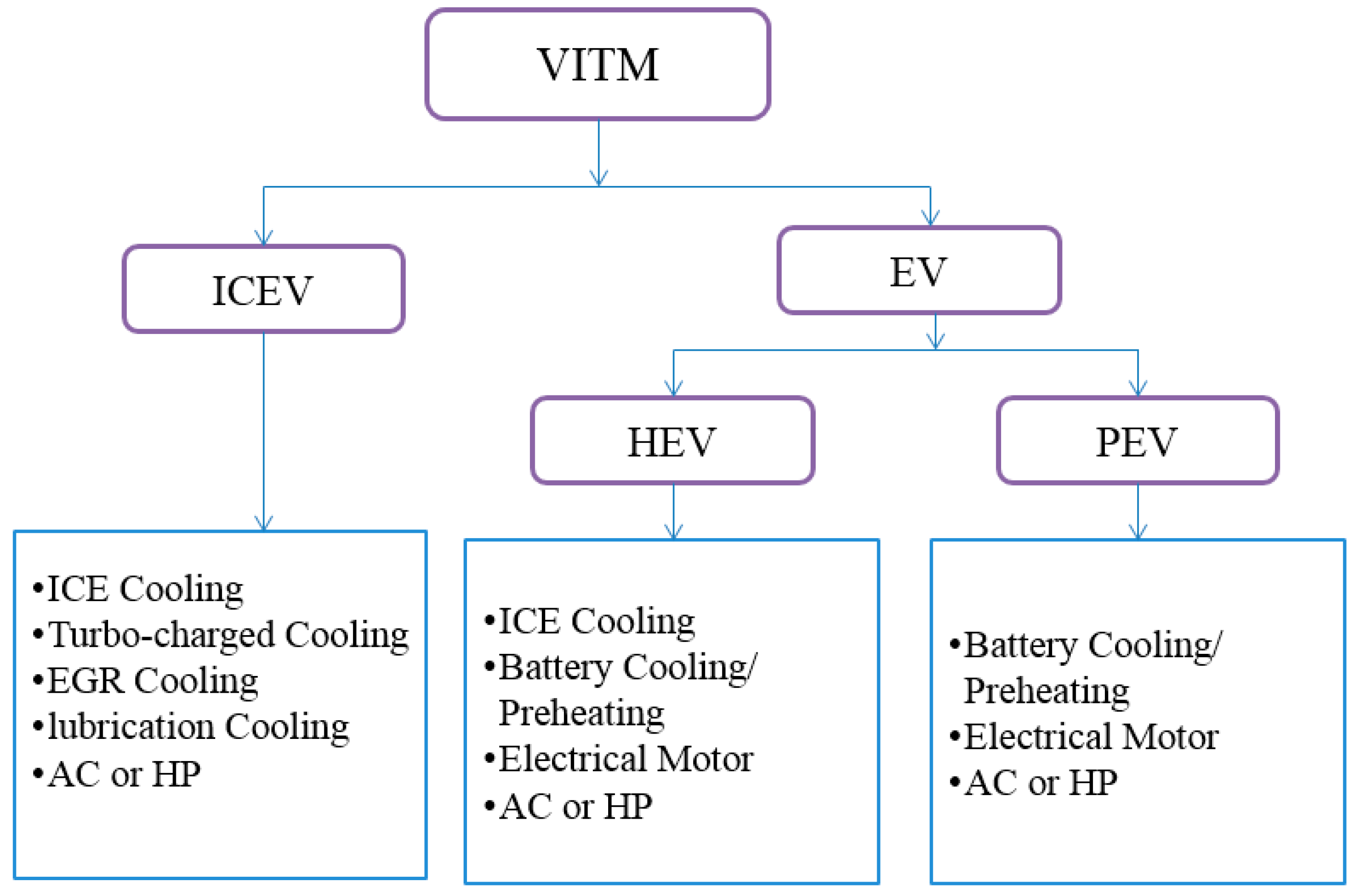
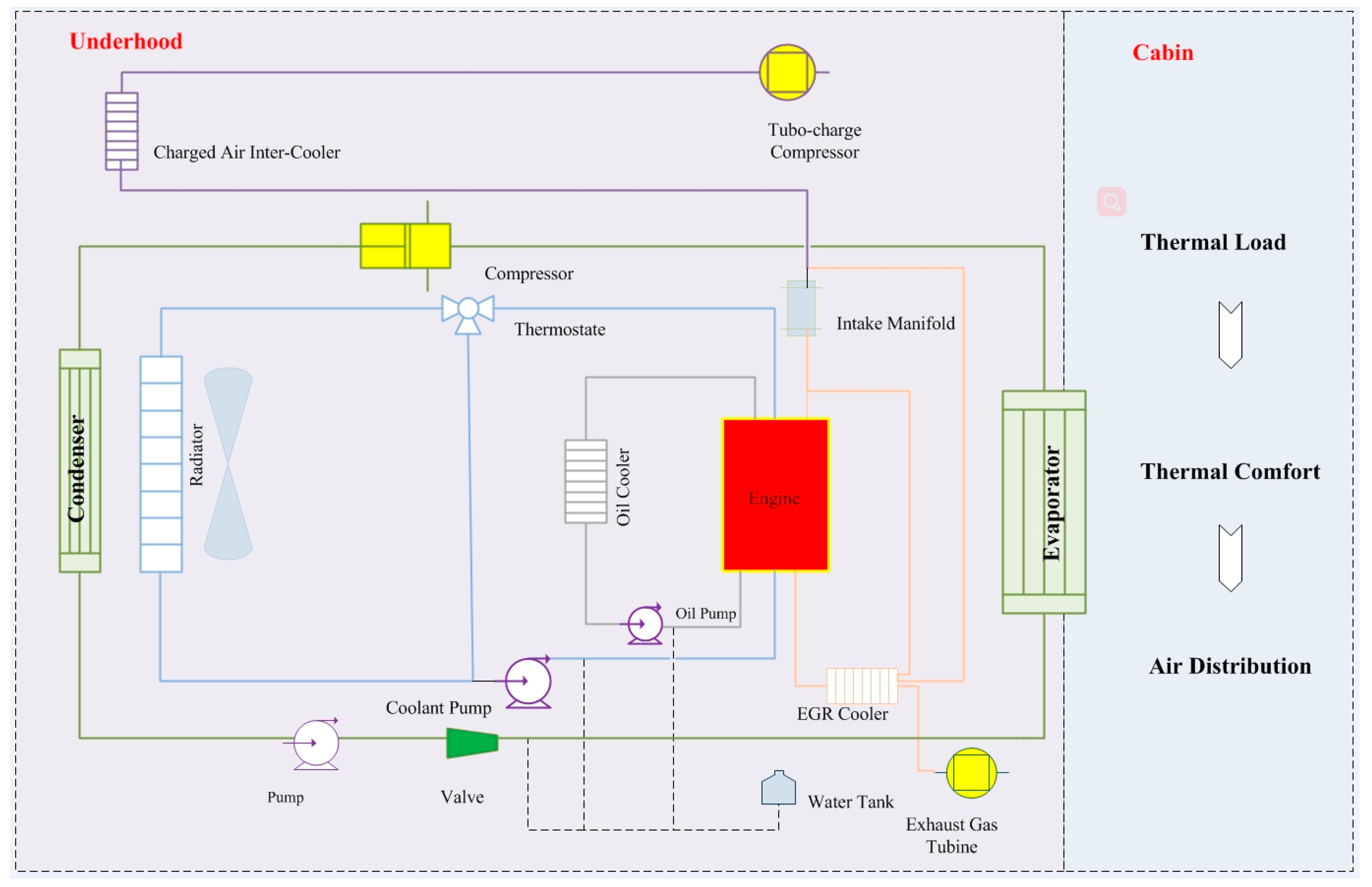
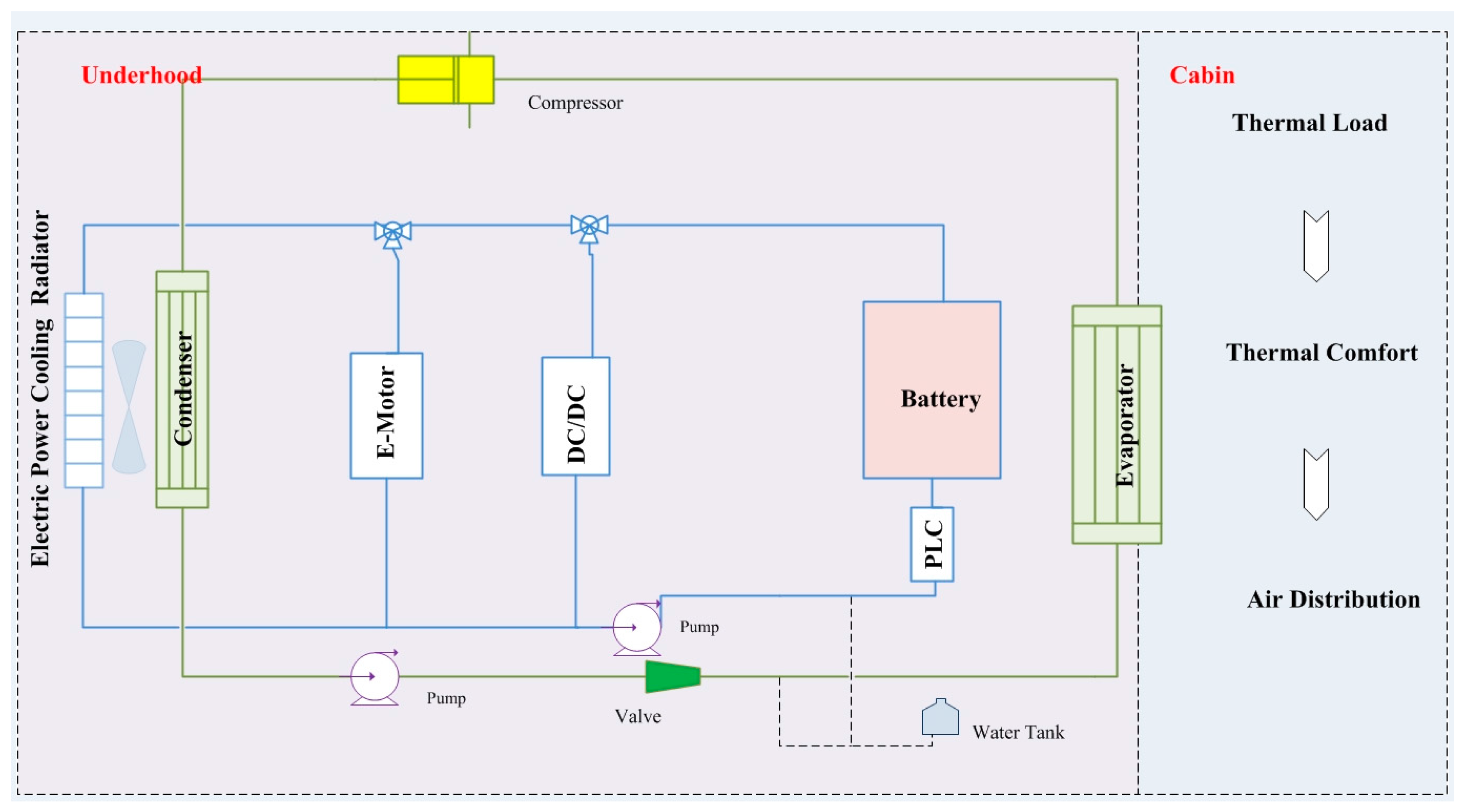
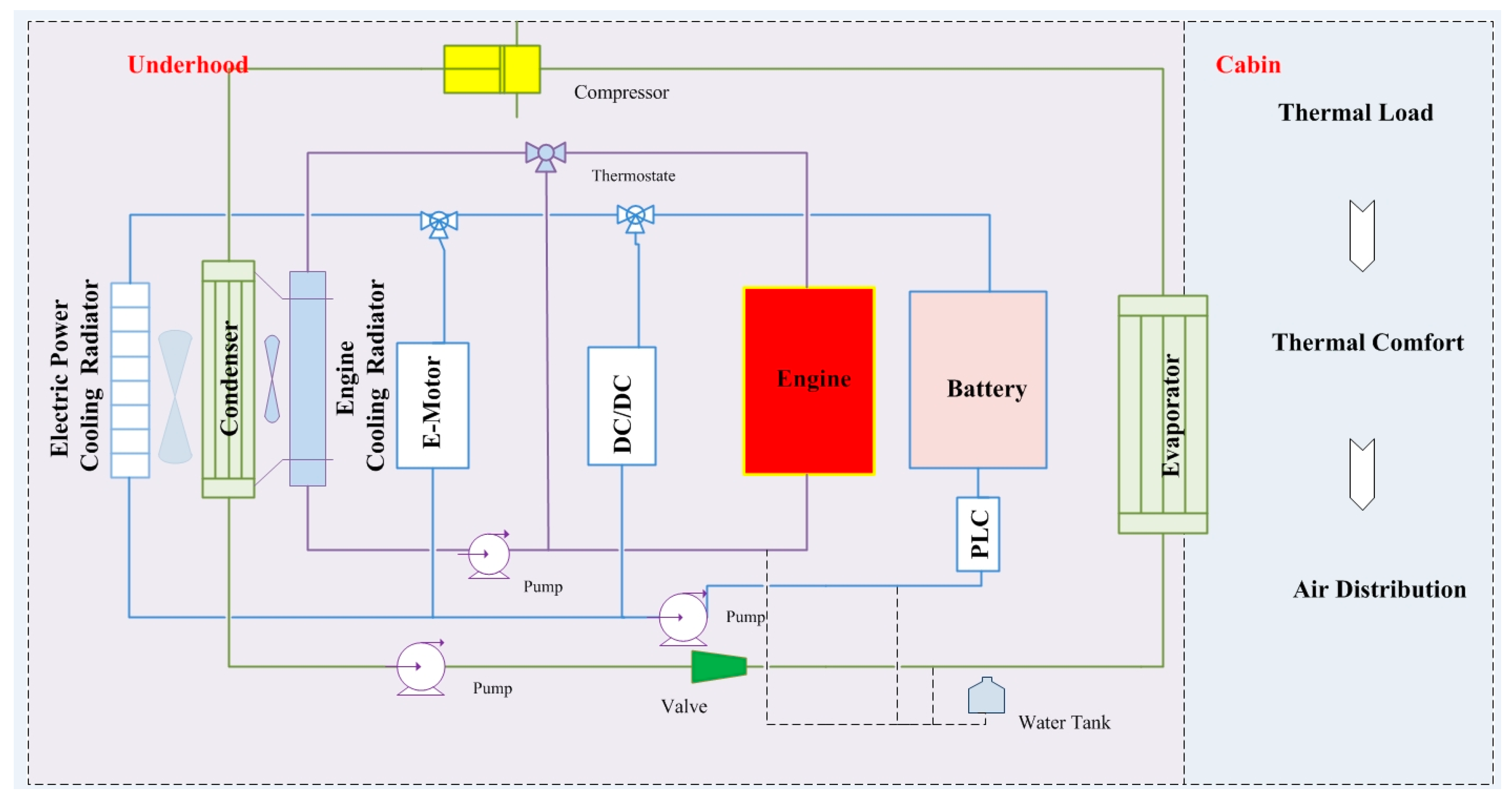

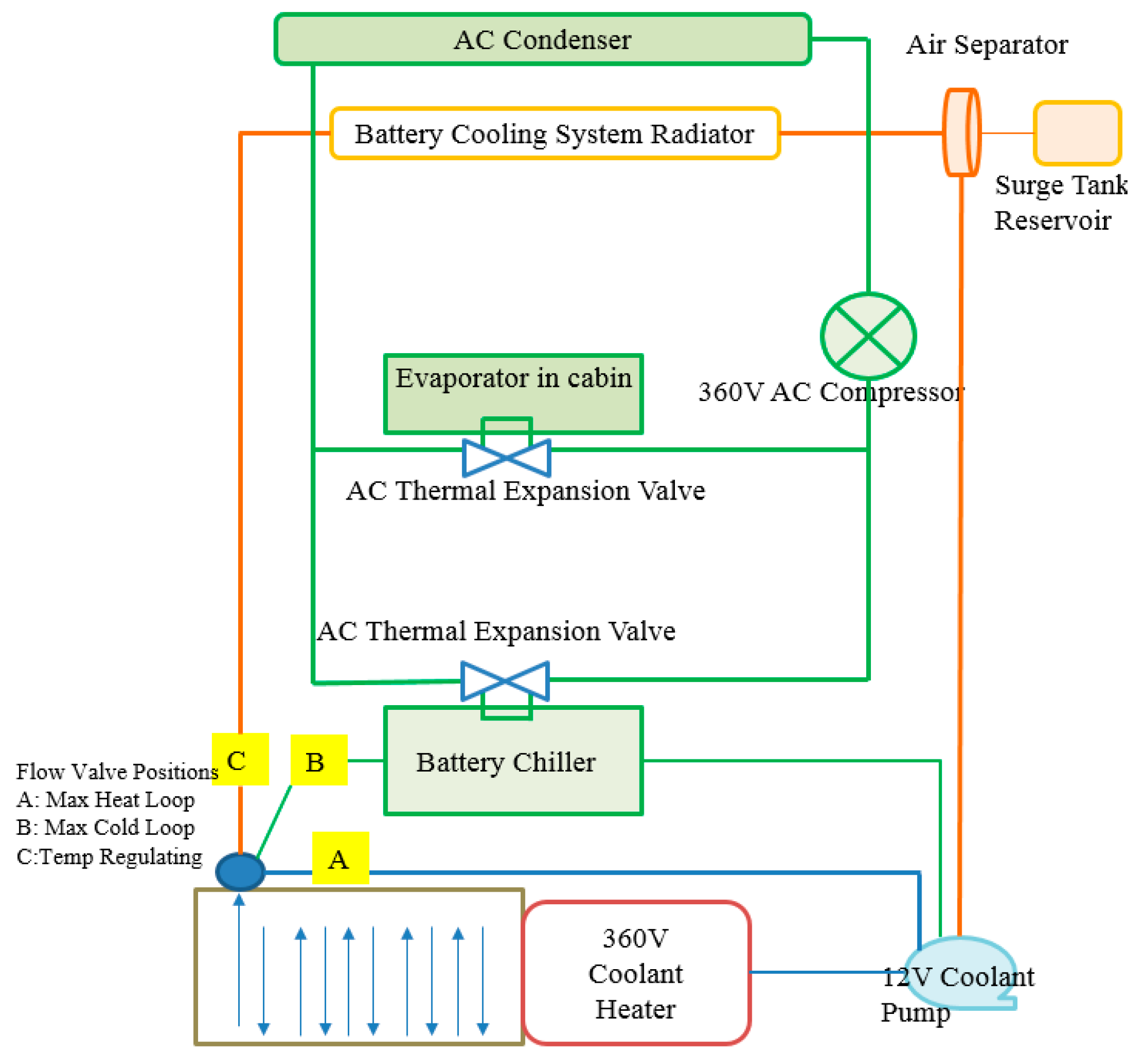
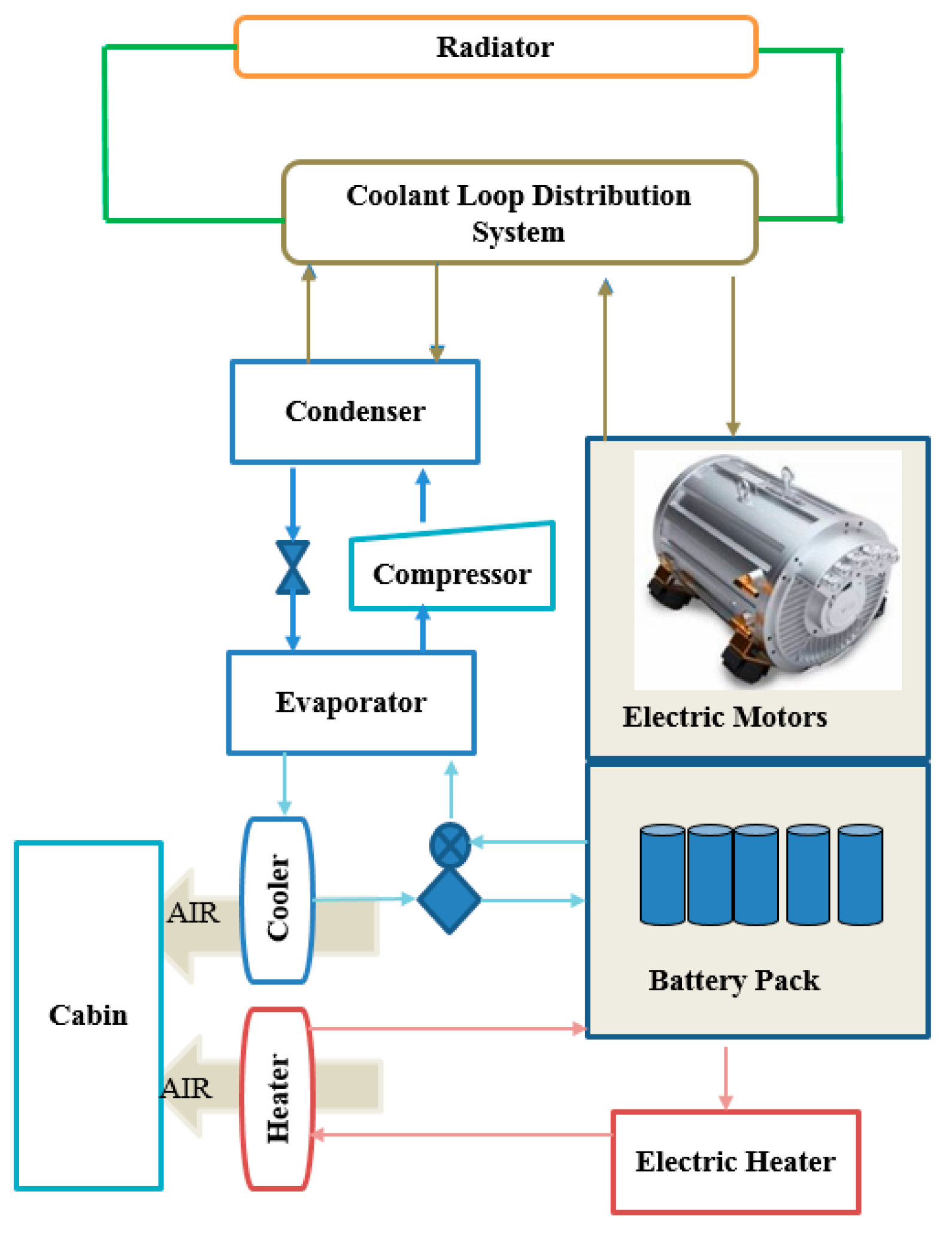

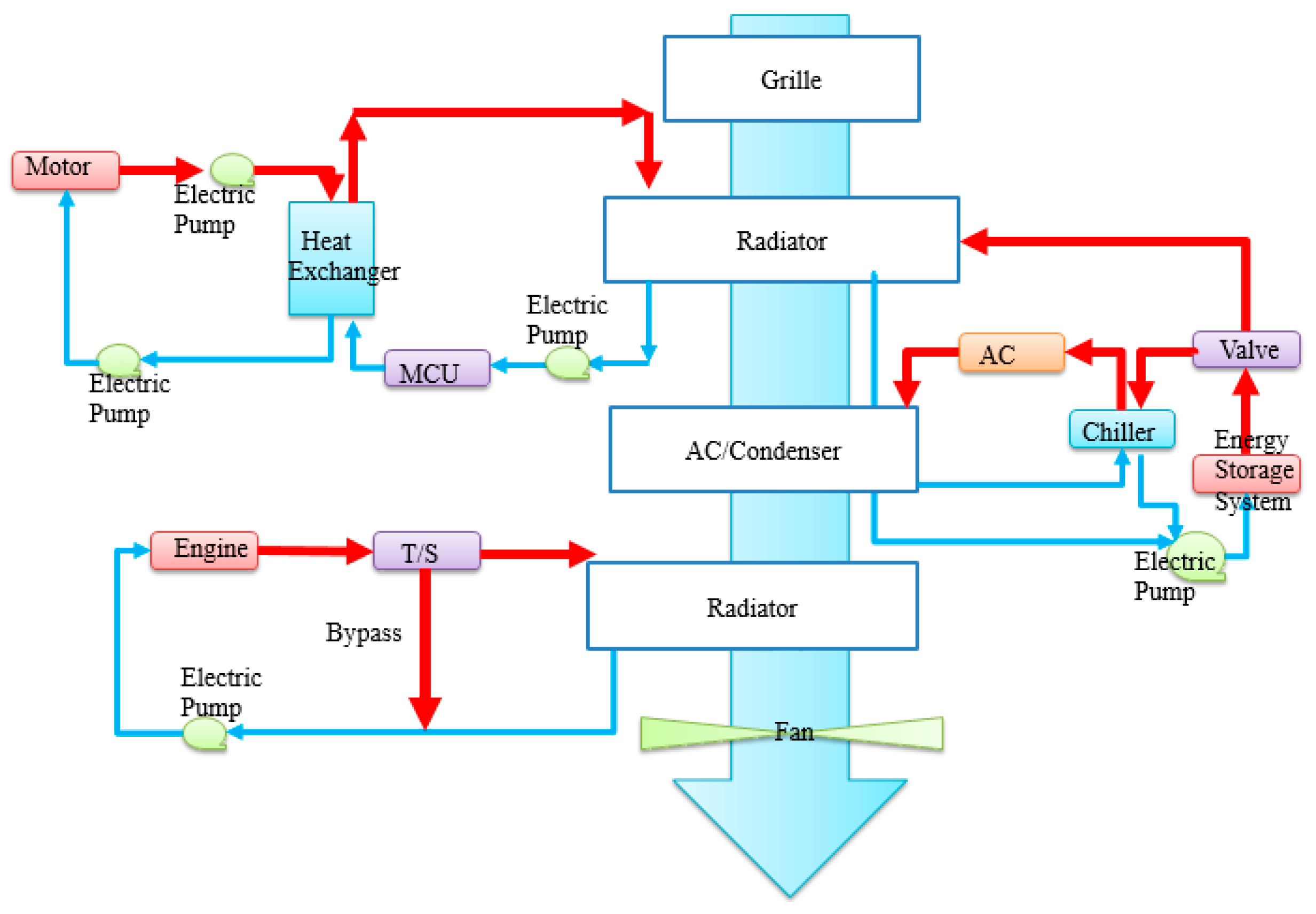

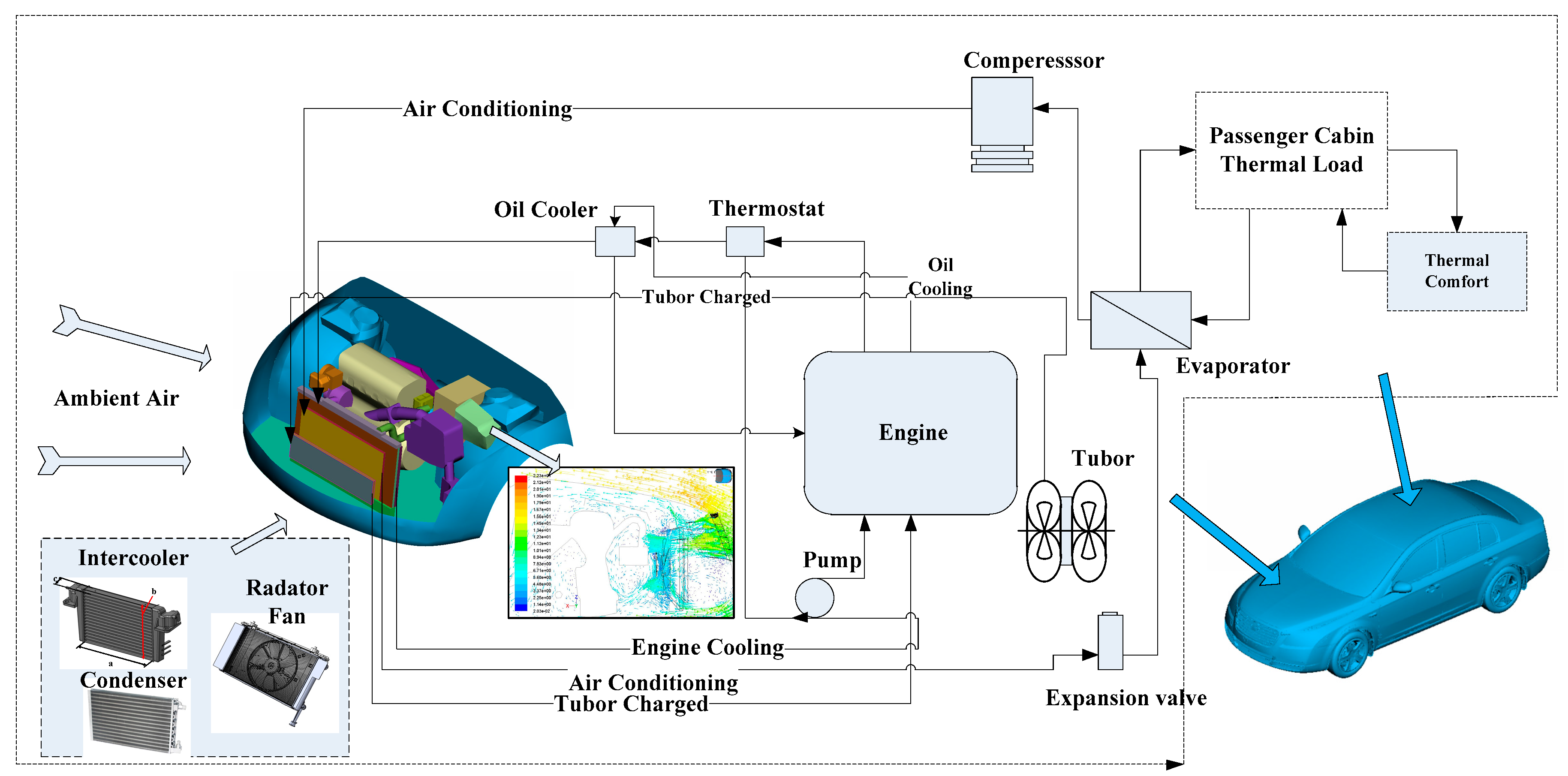

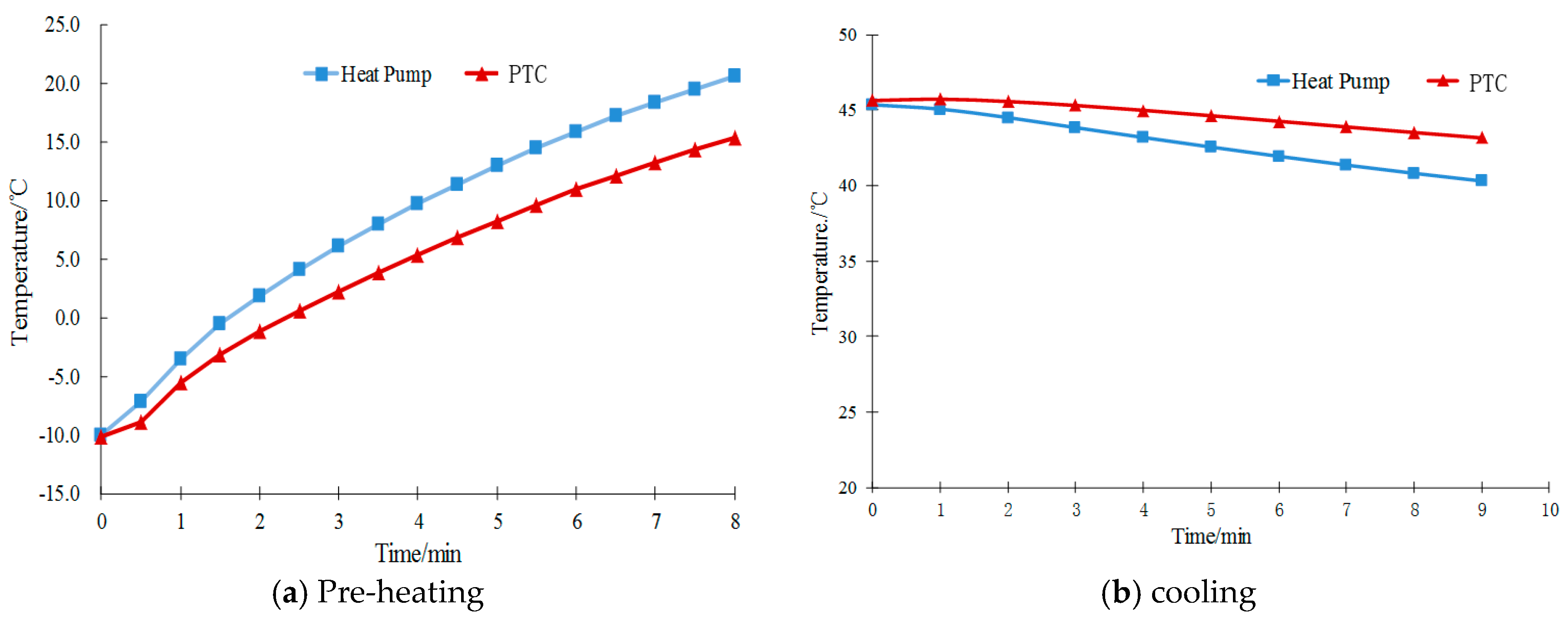
© 2017 by the authors. Licensee MDPI, Basel, Switzerland. This article is an open access article distributed under the terms and conditions of the Creative Commons Attribution (CC BY) license (http://creativecommons.org/licenses/by/4.0/).
Share and Cite
Wang, Y.; Gao, Q.; Zhang, T.; Wang, G.; Jiang, Z.; Li, Y. Advances in Integrated Vehicle Thermal Management and Numerical Simulation. Energies 2017, 10, 1636. https://doi.org/10.3390/en10101636
Wang Y, Gao Q, Zhang T, Wang G, Jiang Z, Li Y. Advances in Integrated Vehicle Thermal Management and Numerical Simulation. Energies. 2017; 10(10):1636. https://doi.org/10.3390/en10101636
Chicago/Turabian StyleWang, Yan, Qing Gao, Tianshi Zhang, Guohua Wang, Zhipeng Jiang, and Yunxia Li. 2017. "Advances in Integrated Vehicle Thermal Management and Numerical Simulation" Energies 10, no. 10: 1636. https://doi.org/10.3390/en10101636



